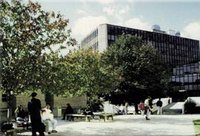Montgomery College Metro station?
When I was a student at Montgomery College, the school posted a great map throughout the school showing the number of Montgomery College students that were citizens of countries around the world. The student body hailed from 191 countries which, they said, was more than at any other institution of higher learning in America. With people coming from all four corners of the world to attend school, it would be nice to make it easier to get there by public transportation.
About half the school’s 60,000 students attend MC’s main campus in northern Rockville. Like its sister campuses in Takoma Park and Germantown, there are no dorms; the entire student body, faculty, and support staff commute. Bike and bus facilities exist on campus, but most people reach the Rockville campus by automobile. Considering that community colleges tend to cater to the less affluent, encouraging car ownership among the students puts an undue financial strain on the student body to own and maintain an automobile.
While the Takoma Park campus enjoys service from both Silver Spring and Takoma Metro stations, both located less than a half mile from the campus, Rockville is not so fortunate. The nearest stations, Rockville and Shady Grove, are three miles apart, and Montgomery College is smack dab in the middle. The wholly unsafe pedestrian conditions along MD-355, which parallels the Red Line tracks, further hampers pedestrian access to either one of these stations. Ride-On and Metrobus service stop at an off-to-the-side bus station on the south edge of campus, separated from the campus’ buildings by a massive surface parking lot.
Crowded parking lots encircle the instructional buildings, creating a hazardous pedestrian environment and a traffic nightmare. The bus facilities should be located in front of the parking lots, not behind them. Campus planners presumably placed the stops there to reduce bus traffic on the campus, but a couple of bus-only lanes could speed the buses and reduce the number of pedestrians walking through the parking lots.
More importantly, there is a huge empty tract of land adjacent to the Red Line tracks literally across the street from Montgomery College. This land is far enough away from other Metro stations that a station here would make sense. A tunnel could run under MD-355 and the MARC tracks to reach the station without any major re-engineering of any of the roads or tracks.
The Red line serves most of the heavily populated areas of Montgomery County, such as Silver Spring, Bethesda, Wheaton, and Rockville. A station at the flagship campus of the county’s primary institution of higher learning would offer transfer-free Metro access from these areas, not to mention out-of-county students, faculty, and employees in the DC area. It would connect the Rockville campus to the college’s Takoma Park/Silver Spring Campus, and with the completion of the Corridor Cities Transitway, the Germantown campus as well. And of course, the Rockville campus would be a one-transfer Metro ride from the University of Maryland and UMUC. My unscientific guess is that it would immediately generate at least 7,000 daily boardings with no effect on the ridership at the neighboring stations, even before new development takes place.
A new Metro station would also serve the Lincoln Terrace Park neighborhood of Rockville, which is otherwise isolated by the train tracks, and the Derwood Industrial Park, a large employment center. The Maryland Board of Education is just south of the Montgomery College Campus. And there is enough dead space around the proposed station that plenty of residential, commercial, and retail development could follow a new station. I would also recommend sinking the tracks to reconnect the street grid east and west of the Red Line and CSX tracks in the area.
If fewer Montgomery College students drove to the campus, perhaps some of those huge parking tracts could become dormitories. Having students walking between the campus and the Metro station would help retail along MD-355. It would provide a valuable transit link between all the campuses of the school system. And most importantly, it would make the school more affordable, facilitating a better-educated population in Montgomery County, the Washington region, and the world.

